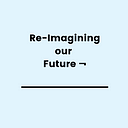Re-Imagining Grief
“Your ‘downs’ turn out to be more interesting than your highs after a while because it’s showing you where you’re aren’t.” — Ram Dass
I’d like to re-imagine grief, not as something that I need to ‘pass through,’ ‘heal from,’ or ‘get over’ but as an inevitable and wise companion on my journey through life. I’d like to think of Grief as an alchemical process: a chasm through which I am invited to pass and be changed by. It is not the kind of change that I can control or will to happen, it is something I must allow to happen to me. It is as if I am standing on the edge of a great and deep gorge, squinting ahead and trying to see the future beyond this gaping gash in the earth and asking what should I do now? What next steps should I take? This chasm is Grief and if I am courageous and vulnerable enough to step down into the darkness, I trust I will be changed by that journey… though I cannot know how. What I see and experience on the other side will be completely different from what I can see now from this near side of the gap. I trust that embracing Grief and feeling it fully will alchemically alter me. The chasm will never leave me either, it will go with me — as part of me — as I move forward in life (and death).
Speaking generally, we live in a death-phobic and grief-phobic society. We are terrified of endings and inaction. We praise accomplishment, doing and achieving. We value that which is life-giving over that which is death-causing time and time again. I would like to invite a re-imagining of our relationship to Grief. I would like to suggest that by feeling our Grief fully and being willing to share it with others that it may become an ally. It seems that we need new companions during these times we are living in and that overcoming fear to journey into the underworld that we are so afraid of will give us access to more ways of seeing and experiencing this world. If we can live with Grief, metabolize it, and allow ourselves to be transformed by it, I believe we may reconnect with important knowings that are simply a part of our being alive, but that we have lost in the age of modernity, development and progress.
Art can serve as a tremendous tool for working with, and expressing Grief, and other emotions. The Artist’s View can help us to genuinely see the palette of the world, with all of it’s hues, the blues, blacks, greens and whites. We are the canvas, and the world paints us, just the same as we paint the world.
Art can help us to see the beauty and mystery in it all. It enables us to reflect, and get to know ourselves, and our surroundings on a deeper level. How often do you include art in your life? Daily? Weekly? Monthly?
How can we include more opportunities for art and creativity in our lives? How would that change the way we act, interact, and see the world? How would that impact the way we view making mistakes? Failing? How might including more art in our lives impact the way that we grieve?
Joseph Campbell said that “the only difference between an artist and a mystic is that the artist has a craft that ties him [or her] to the world.” A mystic expresses their art through their actions. They, themselves, are a masterpiece, creating and being created as they go. They work with all emotions: grief, death, birth, celebration — with complete presence. Presence is the characteristic that ties the mystic and the artist together. No distractions. Embodied acceptance. Working with what is there.
The exciting thing is that we are all inherently creative. We are all artists. We just need space, time and tools to realize this, the same way we just need time, space, time and tools to work with our Grief.
Lead Author: Aerin Dunford (first 2 paragraphs)
Aerin Dunford is a writer, upcycling artist, urban gardener and yoga instructor. She is an independent consultant at Coquixa Consultores using Art of Hosting and other participative approaches as a basis for her work with organizations and groups of all kinds. Aerin is the Chief Basketweaver at The Emergence Network, a translocal community of postactivists posing questions such as: what if the way we respond to the crisis is part of the crisis? Since the death and stillbirth of her son in 2018, Aerin has been called to work with grief in new ways; she has been reflecting, writing and convening others to metabolize loss together.
If you want to learn more about Aerin and her work: Facebook, Instagram, Twitter.
Anchor Author: Daniel Rudolph
Daniel Rudolph is interested in exploring alternative, experiential learning opportunities for people of all ages. He is passionate about forming community, and building public spaces for meaningful, transformational gathering. Currently he is spending a lot of his time learning juggling and facilitating gatherings. He also enjoys writing and sharing poetry. Daniel is a very curious and playful person and is always open for creative collaborations.
